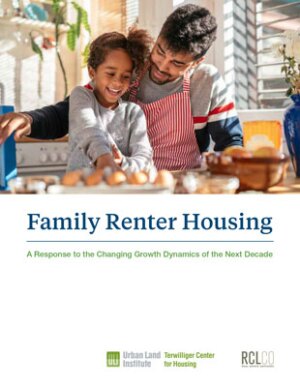The family-oriented U.S. rental housing stock has failed to keep pace as developers have increasingly focused on the youngest millennials who are often single, urban, and transient, rather than on those with families who require larger units, according to a new report released by the ULI Terwilliger Center for Housing and RCLCO.
The report, Family Renter Housing: A Response to the Changing Growth Dynamics of the Next Decade, outlines the business case and need for more family-oriented housing now and in the next decade.
The U.S. Census Bureau estimates that the number of people between 30 and 50 years of age will grow by 8 percent between 2020 and 2030. At the moment, 47.6 percent of millennial households have children compared with 55.9 percent of generation X in the same age range.
This highlights room for growth among millennial households, which in turn will require the development community to create new forms of rental housing that target a broader range of households, particularly family-oriented ones.
“As the world’s 2 billion–strong millennial generation reaches its most economically important age, household formation is increasing, and as families add children, the shortage and cost of rental homes are growing as well,” said Christopher Ptomey, executive director of the Institute’s Terwilliger Center for Housing. “Access to appropriately sized housing at a price that fits family budgets will be critical to businesses’ ability to recruit and retain employees and to the health of city economies. ULI’s Terwilliger Center appreciates having had the opportunity to work with RCLCO to call attention to this substantial opportunity for residential development in markets throughout the U.S.”
Although families represent 33 percent of the overall rental housing market, most new development is not oriented toward them. At the same time, housing preferences are shifting in a way that is becoming increasingly supportive of family-oriented rental development.
Developers cite a number of roadblocks in the push to create more family-oriented rental housing, including the following:
- The perceived level of risk due to the lack of market data suggesting otherwise;
- Regulatory conditions, including entitlement zoning, single-family zoning, impact fee burden, and zoning codes that tend to attract luxury housing above all other types of housing;
- Fiscal policy that discourages new housing due to overcrowded schools; and
- Fear of large traffic impacts in the surrounding areas.
The report recommends a number of potential development responses to this burgeoning market, including:
- Suburban rental apartments: These rental units can serve as transitional living opportunities for families who are searching for more permanent housing nearby.
- Suburban single-family rentals: Typically located in suburban or exurban areas, these units are appealing options for families who cannot yet afford to own homes in the community but someday may wish to do so.
- Rental townhouses: This development type, common in the suburbs, can serve as housing for younger families who are not yet ready to move from their mixed-use neighborhoods but are starting to require additional space.
- Detached and attached apartments: These apartments tend to feature smaller units at higher densities, and appeal to families who want to experience or transition into suburban lifestyles, but who may not want to or cannot afford the larger homes in these neighborhoods.
- Urban rental apartments for families: Although currently uncommon, these rentals have begun to emerge for millennial families who do not want to leave their urban lifestyles, but who cannot afford to purchase large-enough homes in their neighborhoods.
- Mixed-income and affordable housing: This development type is the most common, though it rarely is exclusively oriented toward families. Nearly 58 percent of renters in this space have annual incomes below $50,000 and are facing dwindling market-rate housing options. New development in this space is an important way of providing lower-income families with good, stable housing at lower price points.





